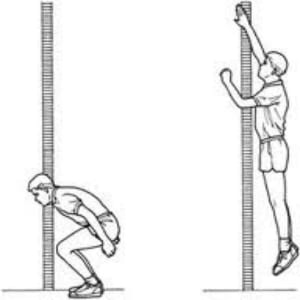 If you want to increase your vertical jump for basketball, volleyball, football, or any other sport that requires an explosive jumping ability, it can be hard to find good information all in one place. You can search for a free vertical jump program, but often times you get what you pay for.
If you want to increase your vertical jump for basketball, volleyball, football, or any other sport that requires an explosive jumping ability, it can be hard to find good information all in one place. You can search for a free vertical jump program, but often times you get what you pay for.
Before getting started with this, realize that there aren’t any easy ways to accomplish this goal, and you need to be dedicated or you won’t be able to see the results you want. A lot of it involves drills that are performed daily in a comprehensive training program. So if you’re looking for the fastest way to go about this, you should relax a bit and settle in for the long haul.
The average vertical jump in the NBA is 28 inches, which is plenty for most guys that are blessed with height as well. If you’re challenged when it comes to how tall you are, you will need to work even harder at being able to jump higher to make up for the difference. If you ever need inspiration, just look at Spud Webb. The Guinness world record is 61 inches, so it’s good to be reasonable when setting your goal.
Vertical Jump Myths and Facts
First let’s dispel some myths on which exercises work, and which you can leave alone.
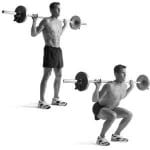
Squats
One of the more obvious looking exercises, and one that is cited many times in regards to helping you with your jumping ability is the squat. Because it mimics the motion you go through when you jump, many assume that it also increases your vertical by growing the leg muscles responsible for propelling you upwards. To be sure this is a great way to train your quadriceps and glutes, two sets of muscles that are important when learning how to jump higher.

Deadlifts
Deadlifts are used by some of today’s top athletes in many sports, as well as celebrities that need to train for movies, like Chris Evans for Captain America. This works muscles throughout your entire body, even though it looks like it’s mostly a leg exercise. This is a good way to build total body strength, but doesn’t provide a lot of direct benefit to how high you can jump, and may add more bulk than you’re looking for.
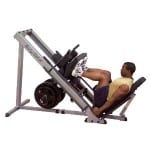
Leg Presses
Leg presses are very similar to the kind of pushing that gets you off the ground. You’re on your back so you can really pile on the weights for this one. It works your quads as well as several other leg muscles. This can be used along with other lifts to increase your vertical, but keep in mind that you do not need to join a gym or lift weights in order to jump higher.
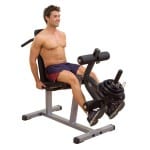
Leg Extensions and Leg Curls
You can find these machines at most any well-equipped gym. These mostly hit your quadriceps and hamstrings, and are a good workout. You can feel the burn in each leg muscle, but the motion does not represent those you’ll be taking when you jump, and they only add bulk to your leg muscles, weighing you down. They are not really necessary, and should be used sparingly with light weights and higher reps.
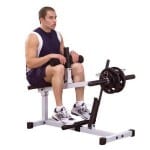
Calf Raises
Many people think that calf raises are key to jumping higher, because calves appear to play a big role in the jumping motion. They are a big contributor, and you will want to work your calves out a good amount. Calf raises are just one of many different exercises you can do to increase your vertical. You can do them with weights, or just using your body weight and an elevated surface of some sort.

Plyometrics
These are static exercises that don’t put you through a range of motion, but are often used in training programs designed at increasing your vertical. One of the most popular is putting your back against the wall for some static chair sits. This engages your leg muscles and you can feel the muscle fibers start to quiver as hits muscles that aren’t used to doing anything. Plyometrics play a big part in your training.
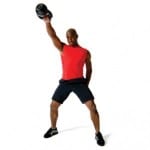
Kettlebells
These are getting a lot of attention in the fitness world, but have really been around for decades. They are like cannonballs with handles, and the workouts you do with them can get pretty intense because they combine cardio with weightlifting so you’re getting a circuit training workout. These aren’t specifically designed to help with your vertical, but it can help with your explosiveness, and getting comfortable with a kettlebell will help with stability and all around fitness.

Special Shoes
You may have seen special platform style shows that make you walk funny, as if you are always going up a step. The thought is that by performing exercises in these shoes you’ll be training the muscles a lot more than by not wearing them. While they may look goofy, there is some validity to what they’re saying, but not really enough to invest your time and money in them. You can get by without them and there are several programs out there that are effective and don’t require any special shoes or equipment.

Upper Body
Don’t forget to give your upper body a good workout on a regular basis. It isn’t in your best interest to just work out your legs and neglect your other muscles. If you look at the physiques of the top stars you will see that all of them have given proper conditioning to their upper body and are well proportioned. Extra time is spent on the shoulders, which helps with setting pics and grabbing rebounds.
How to Increase Your Vertical Jump: Step by Step Guide
We’ve found some of the best exercises to increase vertical jump in a series of three videos which you can see below. But step one is all about preparation, and getting your ducks in a row before you get started with anything.
Step One: Get Ready
Most people just start on the spur of the moment, or spend all of their time thinking about starting, but never actually do. You have to prepare for your training, and be strategic about what you want to accomplish, or you wont’ reach your goal. The first step is research. You probably don’t know much about increasing your vertical, and that’s OK, no one is going to hold that against you. So you need to start reading up on what can help you on your journey and what can’t.
The right information can tell you what muscles are used in a vertical jump so you can focus your attention on those.
Focus on the Fundamentals
The first thing you need to do is get the proper vertical jump form. If you don’t, all else will come more slowly and you’ll delay your progress by many weeks or months, perhaps indefinitely. Whenever you train your body, whether it be weightlifting, running, or jumping, you have to make sure that you are doing the motions correctly to avoid injury and to maximize results. Practice doesn’t make perfect, perfect practice makes perfect.
Get Advice from a Credible Source
If you were a vertical jump expert you would already have a 40 inch vertical. You’re not, and it’s not a big deal. If you’re truly serious about this you can invest in a vertical jump coach to show you exactly what to do. This may be the most expensive way to go, but you’ll be adding accountability and you’ll have someone else invested in your success, doubling the chances that you’ll get where you want to go.
If a coach isn’t in the budget, you can check out a vertical jump training program like the Jump Manual or something similar. This is like having a coach, but without the one on one feeling. The benefit is you can watch their training again and again until you get it down.
Step Two: Perform
Now that you’ve got everything in place and have adequately prepared, it’s time to start putting what you’ve been learning into practice. A lot of people put too much stress on themselves and think that they’ve got to get the action perfect or it’s all a waste of time. This is not true. You shouldn’t take action thinking that you’re getting it right right from the start. You take action, and then you take more action tomorrow, and after enough time as passed you have taken enough action so you can measure your results and see how you’re doing.
In the above video, DeStorm walks you through some basic stretches and workouts to specifically get you to jump higher. He also demonstrates what dorsiflexion and plantar flexion mean and touches on why these motions are so important and often overlooked in discussions about how to increase your vertical jump. Even though the video is labeled as being the basics, some of the drills are pretty advanced, and will get you some great results if you follow them with consistency.
The video series by DeStorm continues. In this video he takes you outdoors and shows you a few more exercises that you can perform, but he also gets into more of the theory, mechanics, and flexibility necessary become a better jumper. He specifically states that you shouldn’t move on to this video until you have done the exercises in the first video for a minimum of two weeks. It’s important to do things in order so you can have the proper form down with the previous drills and be on the same page with what he’s talking about.
In the conclusion DeStorm wraps it all up and shows you a workout routine that you can use in conjunction with everything else you’ve learned up to this point. Of course he can’t show you everything in just a 3 part series, so if this isn’t as in depth as you would like you should consider going with a more comprehensive program. You’ll notice in this video that his physique is not extra bulky, and that his leg muscles are well toned, but not to the point of holding him down or having excess muscle on them.
Step Three: Analyze
This is the fun part. If you’ve been taking action and putting yourself through the drills and exercises you’ve now got things you can study and measure, specifically how high you can jump. If you’ve been trying to lose weight as well, you can weigh yourself and see if you’re on track with that. You can also measure your endurance and speed.
How to Measure Your Vertical Jump – You’ll want to take a measurement before you start your first exercise so that you have something to compare your results to, sort of like a before and after picture. It’s easy enough to measure your vertical. Stand next to a wall and ask a friend to mark the highest point you can reach with your feet flat on the ground. Then jump as high as you can and touch the highest point you can. Do this about 5 times and take the highest attempt. The distance measured between these two points – the flatfooted reach and the jumping reach – is your vertical.
You can also take a before and after video of your measurement-taking or dunk attempts because this will be most revealing in how far you’ve come and where you still need some work.
**Repeat Steps Two and Three as Necessary**
This is the key to the program. Once you have studied what sort of progress you’ve been making, and made your adjustments you go back to taking action. If you find that you’re happy with your progress, you continue to do the same things you’ve been doing, you just do more of them. If you feel that you are not progressing at the rate you’d like, you make changes that you think will produce better results. You then go back and implement those changes for a period of time and then measure those results. Repeat these steps until you succeed.
Think of it as the GPS in your car. You travel along and every once in a while you glance down to make sure that you’re still on the right track. You don’t stare at the GPS and neglect looking out the windshield. And if the unit senses that you’ve missed a turn, it recalculates the new best route. Eventually you end up at your goal. It may not be the exact plan you had when starting out, but continually making adjustments while moving forward will eventually get you there.
Step Four: Maintain
Once you achieve your goal you want to prevent yourself from losing the gains you’ve got. Keeping fit and doing the drills on an ongoing basis is vital for as long as you want to play your respective sport, or be able to brag about your vertical. Your muscles will start to atrophy if they’re not put through their paces regularly, about twice a week at the very minimum. You should also watch what you eat so that you do not experience muscle degradation or put on extra weight that will decrease your abilities.
Other Effective Methods
People often ask if programs like CrossFit, P90X, Insanity, or Asylum work to increase your vertical jump. The short answer is yes, they do. Almost any intense fitness program is going to cause you to jump higher, but that is not their primary goal, it’s more a byproduct of just being more fit overall. Something like the Jump Manual focuses specifically on increasing your vertical jump. There’s no reason why you couldn’t combine these programs, if you need to improve your general fitness as well.
The Foods You Eat
You may not realize it, but the foods that you’re eating play a big role in the kind of abilities you’ll see out on the court or the field. Loading your body with junk or other foods that weigh you down will have a direct impact on what you’re able to do in the gym or the court. Getting the right amount of protein is important, but also eating foods that are plain healthy for you is good. Fruits and vegetables will give you a light feeling and provide you with the energy you need to sustain you through your workouts. You can also choose to supplement your meals with things like Shakeology or other health shakes which provide nutrients you need while following a training program.
Vertical Jump FAQ
There is a lot of misinformation out there on how to get a vertical jump, and what factors play a part. We’ve gathered some of the most commonly asked questions and have provided quick answers so you can quickly get up to speed.
Does Height Affect Vertical Jump?
Height plays a limited role in your vertical. One of the biggest factors is that it adds to your overall weight, making you have to have more thrusting power to get yourself airborne. The thing to consider is that the taller you are, the less vertical you will need to dunk or to play good defense. Of course some of today’s best players have both height and a superior vertical, which is what makes them such a threat.
Does Weight Affect Vertical Jump?
Weight plays a big role when it comes to how high you can jump. It’s just like doing pull ups, it’s harder to do them when you have more weight to hoist up. If you’re currently overweight or are even carrying a few more pounds than you need, you might want to get rid of them. Also, be careful not to overtrain your muscles and bulk up if you’re trying to jump higher. They are more dense and add to your overall weight and will then require you to exert even more effort to lift off.
Does Jumping Rope Help Vertical?
Jumping rope is great for increasing your footwork and being able to make short bursts and get a quick jump to start running. It doesn’t take away from your vertical, but it also doesn’t add a whole lot to it either.
Does Running Affect Your Vertical Jump?
If you’re thinking about training for a marathon at the same time that you are trying to increase your vertical, you might want to hold off on one or the other. This is especially true if you are wanting to get in shape for basketball. For basketball you need to be able to sprint short distances again and again, and also be explosive when you need to and be able to elevate when required.
Can Ankle Weights Increase Your Vertical Jump?
Ankle weights are a good way to increase your vertical, and can be effective if used in an overall system. You can wear them during your drills and training, but only after you have the right form down. This will reduce the likelihood of injury, and can be a way to get out of a plateau if you seem to have gotten stagnant in your progress. You don’t have to do anything out of the ordinary, just do your normal exercises but add the ankle weight to increase the difficulty level.
Does Flexibility Help Vertical Jump?
Staying or getting flexible is key to having a good vertical jump. The jumping motion uses the entire body, even though most people focus their attention on the legs. It’s the locomotion produced by the body getting it’s momentum and moving in unison. Staying flexible allows you not only to jump higher, but also more quickly, and to return safely to Earth with fewer injuries.
Does Creatine Increase Vertical Jump?
Creatine is often taken by athletes to improve their performance, and also to help repair their muscles after an intense workout. You might consider taking it if you are going to train intensely, but it is not necessary for the majority of people.
Does Swimming Increase a Vertical Jump?
Swimming will have a marginal effect on your ability to jump higher. The main benefits of swimming are enhanced cardiovacular ability, and a good way to improve circulation. To get better results in the pool stand up in the shallow end and practice your drills in the water. The resistance of the water is perfect for working out the muscles without adding bulk.
How Long Does It Take To Improve a Vertical Jump?
You should not look for results until about one month into whichever training program you go with. While some programs promise quick results, many times within a week, that is all well and good but it’s best not to look too early. Even if you know you are getting results quickly, force yourself not to check until you’ve dedicated a month to your training. It will be better for your motivation.
Is It Possible To Increase Your Vertical Jump?
Yes. Jumping is not something that many people do on a daily basis. It’s something that just about anyone can attempt to do, but some will be more adept at it than others. Just like with anything you put enough time and effort into, you can see improvements. How big of an improvement will depend on whether you are doing the most effective exercises possible and following good advice.
Is a Vertical Jump Genetic?
Genetics definitely plays a part in how well you’ll be able to jump, but it’s just a starting point and shouldn’t make you give up altogether if you’re not blessed with springs in your legs. Even those that are apparent recipients of good basketball DNA train in the gym and on the court for several hours a day. You only get a chance to see them at game time and don’t see the hours they spend. They treat it like a full time job, and before they were famous were putting in overtime.
Added Bonus: Most Frequently Searched for NBA Stars and Their Verticals
It’s fun to see how high each of these NBA all-stars can jump. For example Dwight Howard, already a menacing presence because of his height and ridiculous physique, can leap 40 inches. Blake Griffin razzle dazzles the fans and stands 6’10 but can also get 3 feet off the ground when he wants to. Add in his reach and he’s well over the rim. When Derrick Rose is injury free he manages to jump 40 inches, and estimates place Gerald Green‘s leaps at 48 inches.
The big three in Miami all have respectable numbers. When Dwyane Wade is healthy he can jump three feet, and Chris Bosh could top that at 39 inches, plus he’s taller. King James is said to have a vertical that is over 40 inches. The OKC Thunder squad is not far behind, with Kevin Durant adding 34 inches to his 6’11” frame, with teammate Russell Westbook edging him out at 36 inches but needing it to make up for the height difference. But both pale to Serge Ibaka‘s 46 inch leaps, rivaling MJ himself.
A lot of players don’t really have their ups any more, but in their day they could climb the ladder. In his prime Charles Barkley could jump 37 inches, and His Airness, Michael Jordan, could jump 48 inches. Kobe Bryant peaked at 38 inches, his Laker buddy Shaquille O’Neal added 32 inches to his giant sized proportions. Paul Pierce put up a respectable 38, and Larry Bird went with the NBA average of 28 inches.
So keep your sights on ways to increase your vertical jump and you could one day join the ranks of today’s elite athletes!
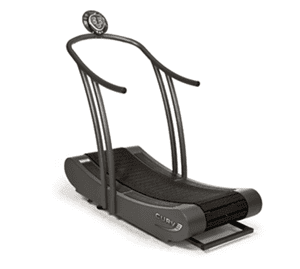


This is a fantastic guide! You put all the useful information in one place in an organized fashion. I’m not a pro basketball player or anything and I’m merely a member of a small amateur basketball league of churchgoers. We may not play as well as the pros but we are just as competitive as them. I want to add some vertical jump to my game and possibly dunk within the game. I can dunk when I’m all alone on the court, but I’ve never done it in game because I just don’t have enough lift. Anyways, I’m gonna try all of these and see if they help me dunk in games. Thanks.